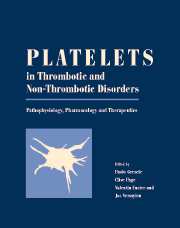Book contents
- Frontmatter
- Contents
- List of contributors
- Editors' preface
- PART I PHYSIOLOGY
- PART II METHODOLOGY
- 30 In vitro assays for evaluating platelet function
- 31 Monitoring antiplatelet therapy
- 32 Flow cytometric analysis of platelet function
- 33 Animal models of platelet-dependent thrombosis
- PART III PATHOLOGY
- PART IV PHARMOLOGY
- PART V THERAPY
- Afterword: Platelets: a personal story
- Index
- Plate section
31 - Monitoring antiplatelet therapy
from PART II - METHODOLOGY
Published online by Cambridge University Press: 10 May 2010
- Frontmatter
- Contents
- List of contributors
- Editors' preface
- PART I PHYSIOLOGY
- PART II METHODOLOGY
- 30 In vitro assays for evaluating platelet function
- 31 Monitoring antiplatelet therapy
- 32 Flow cytometric analysis of platelet function
- 33 Animal models of platelet-dependent thrombosis
- PART III PATHOLOGY
- PART IV PHARMOLOGY
- PART V THERAPY
- Afterword: Platelets: a personal story
- Index
- Plate section
Summary
Introduction
The introduction of glycoprotein (GP) IIb/IIIa antagonists as new and powerful antiplatelet agents has focused attention on the need for methods to monitor antiplatelet therapy. Administration of GPIIb/IIIa antagonists is complicated as they have a very steep dose–response relationship. Moreover, their therapeutic index is low, with the necessity for strong inhibition to see benefit but bleeding complications arising if inhibition is too severe. The traditional method of monitoring by platelet aggregometry has serious limitations and is being replaced by new, faster, more convenient and more sensitive assays.
Platelet function assays
Platelet assays are divided into two groups: physiological assays, which measure the ability of an antiplatelet agent to inhibit a known function of platelets or a biochemical assay, which measures a change in a surrogate platelet marker.
Physiological assays
A major physiological response of platelets to an agonist is to bind fibrinogen and aggregate. Alternatively, platelets can adhere to a matrix without prior activation. Physiological assays monitor platelet aggregation or adhesion. These assays require fresh platelets, specialist equipment and trained staff. While these assays are potentially useful as they provide information on any alteration in the physiological function of platelets, they may not detect more subtle changes indicative of altered platelet function.
Biochemical assays
Surrogate markers of platelet function may also be useful. These include assays that measure changes in a receptor upon binding a drug, assays that measure enzyme function or assays that measure changes in surface proteins upon activation.
- Type
- Chapter
- Information
- Platelets in Thrombotic and Non-Thrombotic DisordersPathophysiology, Pharmacology and Therapeutics, pp. 471 - 484Publisher: Cambridge University PressPrint publication year: 2002
- 1
- Cited by



